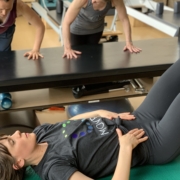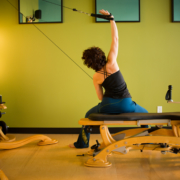How Pilates & Gyrotonic Can Help Strengthen Your Pelvic Floor
Urinary Incontinence – Are You Among the 1 in 3?
Urinary Incontinence – are you familiar with these words? I am sure you have heard the joke – “laugh until you leak” or seen the commercials for “discrete pads for women”. Odds are, if you are a woman, then you or someone close to you is dealing with incontinence on a daily basis. Studies have shown that 1 in 3 women suffer from urinary incontinence – which is an uncontrollable loss of urine. There are two main types of urinary incontinence. Stress urinary incontinence which is when you “leak” when you cough, laugh, sneeze etc, and urge urinary incontinence which is the “gotta go” feeling some women experience and are then unable to hold their urine. It is also possible to have a little bit of both types of incontinence which is referred to as mixed urinary incontinence. You may have heard from friends or read online that at certain times in your life incontinence is inevitable, like when you are pregnant, if you have had multiple children, if you are nearing menopause, or if you are a runner. Well, I have great news for you! You are not destined to have “leaky faucets” just because you fall into any of these categories. There are steps you can take to help improve and even resolve incontinence.
Strengthening Your Pelvic Floor
The key to helping to gain your life back from incontinence lies in a few muscles that most people are unaware they have, or unaware of their function…the pelvic floor. Your pelvic floor is a network of muscles that spread across the bottom of your pelvic cavity like a hammock. They have many functions including supporting the pelvic organs such as the uterus, bladder, and rectum. They also help to withstand increases in pressure that occur in the abdomen with activities such as coughing and sneezing, and they help to enhance the sexual response. These are the muscles you are targeting when doing kegels. Many women have probably heard of kegels, but did you know that studies have shown that most women are unable to perform a proper kegel contraction without some education? It takes diligence, awareness, and practice to perform an effective pelvic floor contraction or a kegel.
How Pilates & Gyrotonic Targets the Pelvic Floor
At MOVE Wellness Studios in our Pilates and GYROTONIC sessions, the pelvic floor is a target of our connection to the “core” and we cue and train the contraction of these muscles as regular part of our private sessions and classes. You learn how to do this in your first session and we work to build tone of the pelvic floor and other related muscles. As small, local stabilizing muscles, it takes a little bit of time and focus to “feel” this area of our body work but quite often, learning to breathe in a way that supports toning the pelvic floor has other benefits such as releasing stress, relieving low back pain and building core strength.
Kegel Exercise to Strengthen the Pelvic Floor
- Sit on a flat surface like a chair or bench with a rolled up towel or pillow between your knees.
- Take a few breaths releasing your shoulders and sitting up tall with your feet flat on the floor.
- Take a breath in to prepare and on your first exhale gently squeeze the towel. Notice the area of your pelvis that is in contact with the chair.
- On your second exhale, try to lift the center of your body off the chair, while gently squeezing the towel. Do not contract your large gluteus muscles but keep the focus more to the center and keep it very gentle.
- Hold the contraction for the length of your breath, relax and inhale and do it again.
- Repeat 10 breaths, twice per day.
Note: this is just a basic introductory exercise and if you have pain or any other symptoms after practicing it, discontinue it and get help from your physical therapist or doctor.
Physical therapy can be a great option for women who are suffering from incontinence that is more severe and truly impacting their quality of life. A pelvic floor physical therapist has special knowledge in the anatomy and function of the pelvic floor and how dysfunction in this area can lead to issues such as incontinence. Your pelvic floor physical therapist will assess your pelvic and lumbar spine alignment, as well as the strength, endurance, and function of your pelvic floor along with related musculature such as your core and gluteal musculature. They will then identify areas of dysfunction to help formulate a treatment plan geared specifically to your needs to help decrease your incontinence and get you back to living your life without the hassles of urinary incontinence.
For more information, join us on May 4th at 5:30PM for Incontinence Night at MOVE Wellness Studios. Click here for more information.
This post was authored by Stephanie Hemker, PT, DPT and Elaine Economou, PMA-CPT







Leave a Reply
Want to join the discussion?Feel free to contribute!